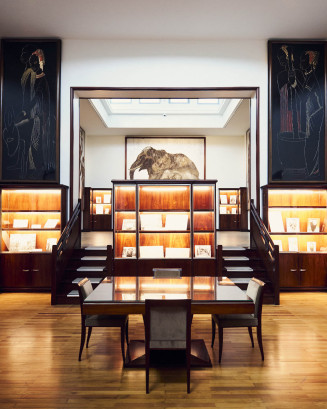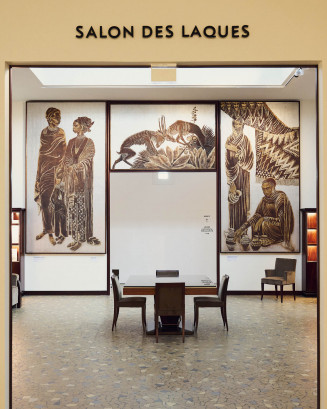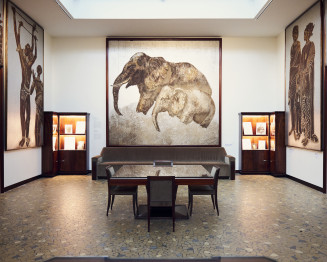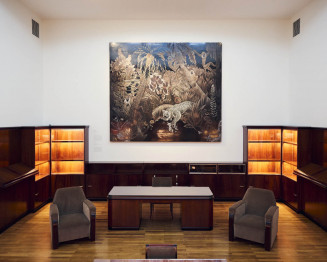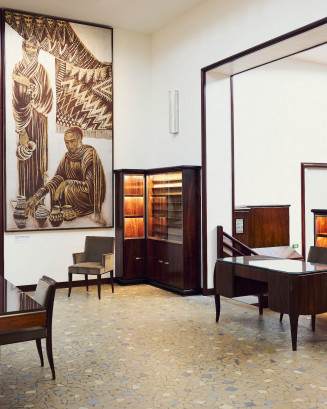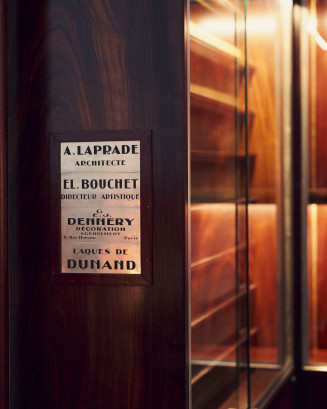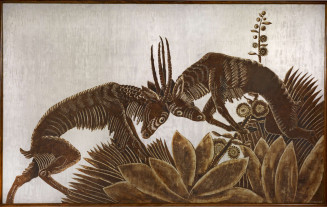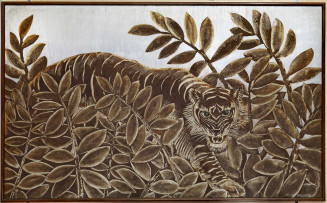The Lacquer Salon
Reconstructed in 2023 at its original location, this Salon was designed in 1931 by the architect of the Palais de la Porte Dorée, Albert Laprade (1883-1978) to welcome visitors to the Musée des Colonies. It was reunited with the original rosewood furniture from Madagascar, classified as a historic monument, and the lacquer panels created by the outstanding artist Jean Dunand that decorated it at the time. This exceptional set of furniture and decorative items represent an important testimony to the Art Deco style.

Legende
Paris. Library of the musée de la France d'Outre-Mer.
Credit
© Albert Harlingue / Roger-Viollet
The furniture
The furniture, consisting in around twenty high-quality pieces made from African walnut and Madagascar rosewood, was made by the Dennery company, renowned cabinetmakers in the Faubourg Saint-Antoine, under the artistic direction of Léon-Émile Bouchet.

Madagascar rosewood table in the lower section of the Salon des laques. Made by the Dennery company under the artistic direction of Léon-Émile Bouchet.
Photo : Cyril Zannettacci © Palais de la Porte Dorée, 2023
Until 2020, the furniture from the library had been disassembled, dispersed throughout the reserve stores or used to furnish the administrative offices of the Palais de la Porte Dorée. The appearance of the wood veneers was particularly faded and even discoloured. They were restored in 2022 by the Ateliers de la Chapelle, a cabinetmaking workshop specialised in restoring heritage pieces, bringing back all the original shine and the dark red colour with its vibrant veins made from Madagascar rosewood.
Unlike the Art Deco furniture usually destined for a wealthy, avant-garde clientele – like the Ruhlmann and Printz furniture in the historic salons (Africa Salon and Asia Salon) – this furniture had a primarily utilitarian purpose and was intended for use by visitors to the Musée des Colonies.
The lacquer panels
In addition to its furniture, this double salon was decorated with ten lacquer panels designed and produced by Jean Dunand (1877-1942), a key figure in the Art Deco movement.
The ten lacquer panels, which were hung in the Musée Permanent des Colonies in 1931, are divided into two groups, each situated at a half-level of the Lacquer Salon. These panels, whose creation represented the high point in Jean Dunand’s artistic career, had been added to the collections of the Musée du Quai Branly - Jacques Chirac in 2006, along with the collections of the Musée National des Arts d’Afrique et d’Océanie (MNAAO), which used to be at the Palais de la Porte Dorée.
The lower level features three panels made from black “Coromandel” lacquer, using the laque défoncée (“beaten”) technique. The largest one, La Forêt, with an impressive size of 3 by 3.35 metres, was made from black lacquer whose different layers were engraved and brightened up with silver or red paint in the incisions. While the black contours of the pattern remain in relief, the engraved incisions are either left as is (for example, the signature engraved on the right as far as the preparatory layer in a brown colour), or enhanced with colour pigments (like the feline with silver paint, or the leaves in red). This panel was restored in 2022.
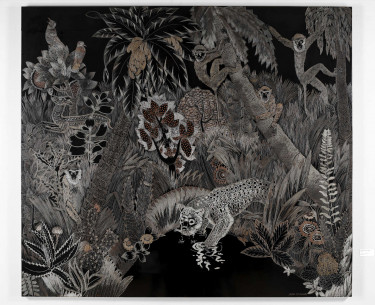
Legende
La Forêt, Jean Dunand, 1929, 2,95 x 3,34 m, 250 kgs
Credit
Photo : Patrick Gries © Musée du quai Branly - Jacques Chirac
The two Sénégalaises panels, 3 metres high by 1.29 metres wide each, which pair up with La Forêt, were created using the same technique. Inlays made from red-lacquered brass and bone materials (bone or ivory) were added to this.
The upper level features 7 panels made using the laque arrachée technique, which Jean Dunand experimented on, far-removed from the standards of traditional lacquer art. Against a background of aluminium sheets arranged in small squares like gold leaf, the artist applied thick layers of lacquer mixed with clay and iron oxide. While still fresh, the lacquer is worked with a wooden spatula to create a raised effect and create patterns whereas the panel is monochrome.
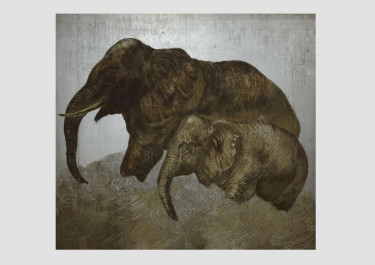
Legende
Les Éléphants, Jean Dunand, 1930, 342 x 298 cm central panel, 342 x 33 cm each side panel, total dimensions 342 x 364 x 3 cm, 105 kgs
Matt brown laque arrachée on silver lacquer background (aluminum)
Credit
© Musée du quai Branly - Jacques Chirac, photo Léo Delafontaine
In the Éléphants panel (3.50 m x 3.60 m), the laque arrachée technique helps create the elephants’ grainy skin and the movement in the grass at their feet. In this monochrome panel, the pattern is sculpted: the mother’s skin is made up of thick layers of lacquer that has simply been striated, whereas the baby elephant’s ear stands out as a result of deeper scraping, revealing the silver background. Unlike painters who add matter, here Jean Dunand was acting as a sculptor.
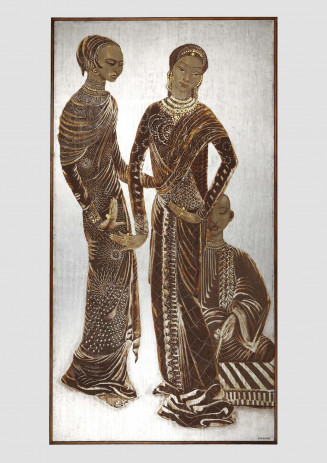
Legende
Les Peuples d'Asie (Indochine), Jean Dunand, 1930, 3,40 x 1,78 m
Matt brown laque arrachée pannel on silver lacquer background (aluminum)
Credit
© Musée du quai Branly - Jacques Chirac, photo Léo Delafontaine

Les Peuples d'Afrique (Sénégal), Jean Dunand, 1930, 3,45 x 1,85 m
Matt brown laque arrachée pannel on silver lacquer background (aluminum) with ivory, brass and metal inlays
© Musée du quai Branly - Jacques Chirac, photo Léo Delafontaine
